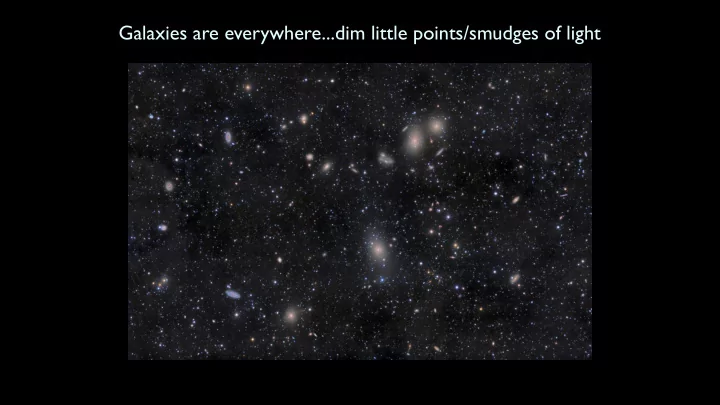

Galaxies are everywhere...dim little points/smudges of light
Whirlpool Galaxy: image taken with our own telescope! the size of the field of view of our telescope is 26 arc minutes
Galaxies are everywhere...dim little points/smudges of light This is an especially dark, uninteresting small part of the sky (2.5 arc minutes across)
Virgo cluster: nearest big galaxy cluster
Virgo cluster: nearest big galaxy cluster
Galaxies are everywhere...dim little points/smudges of light and we can detect supernova explosions in them, even when they only cover a few pixels!
2df galaxy survey: each dot is a galaxy
there is a limit to the size scale of structure (~100 million light years)
Large scale structure simulation zoom in
but first, The Cosmological Principle weak : the Universe is the same everywhere (homogeneous and isotropic on large scales) strong : also, the same at all times
but first, The Cosmological Principle weak : the Universe is the same everywhere (homogeneous and isotropic on large scales) strong : also, the same at all times
Contents of the Universe changes with time: Quasars as a function of redshift (and thus distance and lookback-time)
but first, The Cosmological Principle weak : the Universe is the same everywhere (homogeneous and isotropic on large scales) strong : also, the same at all times strong: ruled out by observations; including the darkness of the night sky
Olber’s paradox: if the Universe (or forest) were infinitely large, we’d see a star/galaxy (or tree) in every direction
Cosmological Principle: Universe is the same everywhere homogeneous? scale is the key
Chuck Close, Maggie, 1996 Jackson Pollock, Number 1, 1950 (Lavender Mist)
a wheat field is homogeneous...but that characterization depends on the scale
and it might be homogeneous without being isotropic view from the left vs. the right?
we observe isotropy on large scales; if we are not in a special place , then this implies global homogeneity
On small scales, the Universe is clearly not homogeneous Working our way out from Earth in increasingly larger scales, here are some examples of inhomogeneity
Earth and Moon: sizes to scale
Earth and Moon: sizes to scale and distance to scale
The Sun, our star: 8 light minutes away and 4 light seconds across
The Sun, our star: volume about a million times larger than the Earth
the distribution of stars in the sky is not uniform
we live inside a flattened disk of stars: the Milky Way Galaxy
Milky Way composite, seen from Earth’s surface
Our neighbor galaxy: Andromeda
Andromeda: thought to be much like the Milky Way corresponds to our location in the Milky Way
Our neighbor galaxy: Andromeda infrared view
The Whirlpool Galaxy (M51): grand-design spiral
characterization of individual stars in galaxies: starting around 1915
Virgo cluster: nearest big galaxy cluster
Virgo cluster: nearest big galaxy cluster
Edwin Hubble (late 1920s)
Part of what made it possible to determine that Andromeda is a separate galaxy was the discovery of Cepheid variable stars by Henrietta Leavitt she also developed a clever method for using these variable stars as distance indicators
Hubble’s original (1929) velocity-distance relationship
Hubble constant determinations over time
Recommend
More recommend